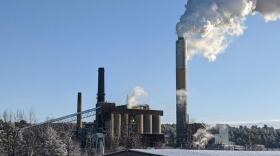Jews make up just 2% of the U.S. population. But according to the Anti-Defamation League, they’re the target of the majority of religious-based hate crimes — nearly 60%.
The ADL reports that Connecticut saw a 42% increase in antisemitic incidents in 2021 over the year before. Those incidents included a bomb threat, as well as vandalism and harassment at Jewish institutions, schools, homes and online. Neo-Nazi and white supremacist flyers have been found in 20 towns in the state since February of this year, according to the ADL.
“The data is quite alarming,” said Avinoam Patt, a professor and director of Judaic studies at the University of Connecticut. “But at the same time, this conforms to our understanding of how antisemitism functions throughout history.”
Patt said antisemitism is often called “the oldest hatred.”
“But it really functions as a type of conspiracy theory, which often goes hand in hand with other forms of racism, xenophobia, discrimination,” he said.
Megan Black, director of the Common Good Program at the nonprofit Western States Center, works in racial justice and faith-based organizing She said growing antisemitism nationwide has fed into what’s known as the “great replacement” theory.

“This idea that the white Christian majority in the country is being displaced by non-Christians and by Black people and by brown people, and that Jews are actually the ones who are responsible for that replacement,” Black said, explaining the conspiracy theory. “That it's a plot by a global cabal or some kind of secretive Jewish conspiracy group that is pulling the strings on these puppets.”
The “great replacement” theory puts a new label on old fears. Populist leaders — like fascist leaders of the past — warn that a group of outsiders is threatening the safety and survival of the majority. This fear is used to justify action against the “other.” As people buy into this conspiratorial thinking, Black said they lose faith in democracy.
“It boils down ultimately to this act of having to share power in a democracy and this experience of feeling extremely threatened by that in this society right now,” she said.
These theories — that Jews somehow pull the strings, and that others are therefore threatened by it — have painfully practical manifestations. The link between hate and violence is playing out in everyday America.
“For those of us who were paying attention to what the insurrectionists on Jan. 6th were wearing and saying, we could see this overlap between extreme white nationalism and Holocaust denial,” Patt said. “[It’s] the same thing that we could see at the Unite the Right rally in Charlottesville in August of 2017, the sort of chanting of ‘Jews will not replace us.’”

The key to addressing the problem? Patt says it’s education.
“Listening to one another, hearing about one another and knowing when it is time for us to speak out against all forms of hate speech when we encounter it,” he said.
And Black says that if the design of antisemitism and white supremacy is to divide communities, then it’s up to people who it seeks to marginalize to come together.
“So one of the most important things we can do is seek to be in relationship, in partnership with each other,” she said.
Learn more
Cutline, Antisemitism Rising: Bearing Witness Then and Now
July 28 at 8 p.m. on CPTV
The Holocaust remembrance movement says "never forget" but surveys find the problem is deeper - many people lack basic knowledge of the Holocaust. On Cutline: Antisemitism Rising: Bearing Witness Then and Now, hear the personal stories of Holocaust survivors living in Connecticut, visit a Connecticut classroom teaching the Holocaust, explore links between antisemitism and extremism, and learn the story of Sobibor, a site of bravery and resistance.





